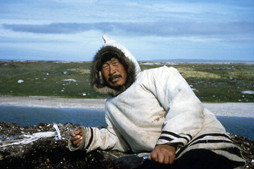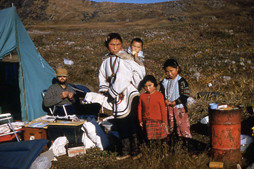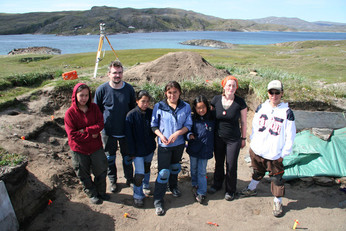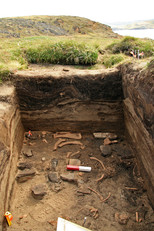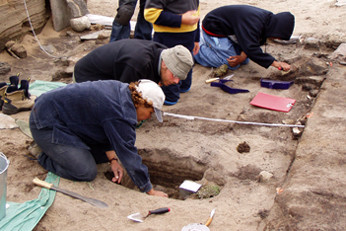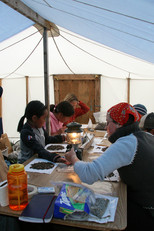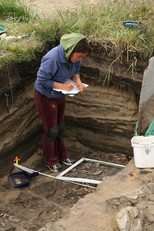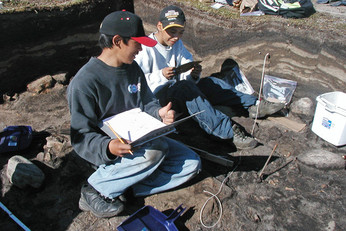- About
- Discovering Archaeology
- Projects and Activities
- Online Resources
- References
Archaeology
Multidisciplinary research at the Tayara site (KbFk-7)
Since 2001Historical background
In the late 1950s, William Taylor carried out research in the Hudson Strait area while studying the origins of the Dorset people. He arrived in Sugluk village (now Salluit) in September 1957, where Toonoo, a local Inuk, told him of various sites located on Sugluk Island (now Qikirtaq). They visited the island, where Toonoo showed Taylor several archaeological sites, among them Tayara (KbFk-7).
In 1958, toward the end of his excavation projects, Taylor revisited Sugluk Island, naming the site Tyara (Tayara) in honour of his boatman/guide [ 1 ]. The archaeologist was astonished by the site’s abundance. Six excavation trenches explored over a 10-day period yielded a plentiful collection of artifacts. A decade later, in 1968, Taylor published his findings, using data from the Tayara site as the foundation of his concept of continuity between the Pre-Dorset and Dorset cultures. Taylor had several artifacts dated, leading to his assessment that his findings at Tayara were from the Early Dorset period.
Site location
Tayara is located in the main valley of Qikirtaq, a small island along the continental southern shore of the Hudson Strait, near the community of Salluit. The site is situated at 18 metres above sea level, not far from the coast.
Multidisciplinary participation
In 2001, Daniel Gendron undertook a CURA project, From the Tuniit to Inuit, in an effort to pursue the research Taylor began at Taraya. The site’s archaeological abundance was a strong motivator for the research team. In 2002, almost 50 years after Taylor’s first trenches, excavation began again. At the outset, a multidisciplinary team was assembled, representing a wide variety of fields:
- geomorphology and geoarchaeology [def] (Najat Bhiry, Professor at Université Laval, and Dominique Todisco, then a doctoral student at Université Laval),
- zooarchaeology (Hervé Monchot, Institut de Paléontologie Humaine, Paris),
- lithic technology and lithic raw materials [def] (Pierre M. Desrosiers, Avataq),
- the technology of hard organic materials (Claire Houmard, doctoral student at Université Paris 10 – Université Laval),
- spatial analysis and stratigraphy [def] (various members of the research team),
- skin and hide processing technology including technical and use-wear analysis (Marie-Michelle Dionne, doctoral student, Université Laval).
Since 2003, Pierre M. Desrosiers and his main assistant, Josée Boudreault, have managed further research at Tayara. After several years’ excavation, the site’s analysis phase is well underway and is expected to continue for a few more years. Several publications on the project have already been released, with many more planned.
Selected research results
Since 2001, five seasons of archaeological excavation have allowed us to gather a varied collection of material culture made of stone and organic materials. The excavations also gave us the opportunity to reveal the structure of homes and other dwellings, and to collect various artistic samples, some of which depict anthropomorphic or animal figures.
We have also been able to date various samples from the site, allowing a more complete understanding of Tayara’s chronological frame. The material culture extracted from level [def] II would indicate that the site dates from the Classic Dorset period. The site, however, has an older lower level that has yet to be fully excavated.
With the help of Université Laval’s geomorphologists, we were able to gain better understanding of local sedimentation and the site’s overall formation, as well as the region’s climatic history.
An educational opportunity for Inuit students and teachers
This series of excavations allowed us to introduce archaeology and excavation methods to local Inuit youth. For Inuit students enrolled in the Bachelor of Education program at McGill University’s First Nations and Inuit Education Office, our research has provided an excellent teacher training opportunity in archaeological methodology, as well as an introduction to the region’s cultural history.
[ 1 ] Taylor, in his 1957 field notes, uses the name Tayarak. In 1958, he switches to Tyara (Taylor 1957b, 1958b). For reasons unknown, he maintains this phonetically incorrect spelling, Tyara, for his 1968 book. According to Inuktitut norms, the correct spelling would be “Tajaraq” (Qumaq 1991: 257). In Salluit, however, the descendants of Taylor’s guide use “Tayara.” As Taylor wished to honour his guide, we have chosen the spelling preferred by the honoree’s modern-day family.
Documents en ligne au sujet de ces recherches
Poster
Micromorphology of periglacial sediments from the Tayara site, Qikirtaq Island, Nunavik (Canada)
Najat Bhiry, Dominique Todisco
2008
Research Report
Tayara site (KbFk-7), Qikirtaq, summer Fieldwork 2006, AR248
Avataq Cultural Institute
2007
Poster
Formation Processes of a Dorset Site in Periglacial Enviroment. A View From Tayara (KbFk-7), Southern Shore of Hudson Strait, Canada
Noura Rahmani, Dominic Todisco, Pierre M. Desrosiers, Daniel Gendron, Najat Bhiry
2006
Poster
The Tayara Site (KbFk-7, Dorset Period, Nunavik) : Preliminary Results of a Typo-Technological Study
Claire Houmard
2006
Research Report
Tayara Site (KbFk-7), Qikirtaq, Summer Fieldwork 2005, AR241
Avataq Cultural Institute
2006
Poster
The Tayara Site (KbFk-7), New Excavation & Preliminary Results
Daniel Gendron, Pierre M. Desrosiers, Noura Rahmani, Dominique Todisco, Rajat Bhiry, Mosusie Nuluiyuk, Josée Boudreault
2004
Research Report
CURA 2001-2003 from Tuniit to Inuit: Three years of research at the Tayara site (KbFk-7), Qikirtaq. Summer fieldwork 2003 and preliminary synthesis, AR064
Avataq Cultural Institute
2004

